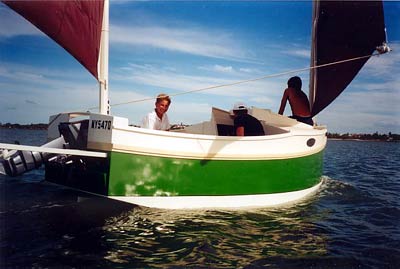|
The Skipper
Mike Rowe stood in the companionway
of his small cat-yawl holding a mug of black coffee, which was
now half-cold due to his habitual day-dreaming. He was at last
starting to relax after the mental and actual turmoil of the preceding
days. It seemed to him that the only place he could really unwind
was on the water, and the current conditions were his favourite.
A light north-easter was moving his keel-sharpie steadily past
Earlando Resort and he was anticipating with satisfaction the
first mental milestone of his outing – Gloucester Island.
Mike, who was approaching middle
age with at least some grace, had calculated a speed over the
ground of 4.63 knots since departure four hours earlier. He was
also a habitual calculator. At this rate they should reach the
rendezvous with his friend Ian by one pm the next afternoon, allowing
for the present favourable ebb tide.
Although Mike’s coffee was
now cold and unfinished, it had provided him with satisfaction
beyond measure, just by having been prepared in the tiny cabin
while the boat steered herself. How many times he had dreamt of
such activity he could not have told anyone; but although long
in the gestation, the situation had been as sweet as he had anticipated.
The other activity he had particularly
enjoyed was lighting the kerosene navigation lights. These had
come from a supplier in Canada many years before (he also habitually
bought gear before it was needed, as though it would bring a cherished
project to fruition ahead of time!) and promised to be a worthwhile
investment as long as the contents of the reservoirs could be
prevented from permeating the vessel. To this end, the skipper
had stored the filled lights in a plastic nappy bucket. This he
had chosen because of its robust construction and close-fitting
lid. It normally resided in the aft free-flooding well, where
kero spills could be washed away with seawater. They were more
reliable than the corroded wiring of his mate’s GRP sloop
– electricity had its place, but that place was not on a
small boat.

Just after eight pm, Mike went
below to rest. Had anyone else been present he would have justified
his action on the grounds of tiredness – but as he was alone
he could indulge himself for the real reason, which was that he
loved to feel the little yawl steer herself. The feeling was heightened
enormously when he went below. The wind was forecast to veer,
so any unnoticed course change should be towards open water. A
medium sized, spherical compass was mounted through the main bulkhead,
so he could monitor headings from the bunks as well as from the
cockpit. Danger of collision was his only concern, but during
construction he had stuffed crumpled aluminium foil inside the
hollow wooden masts to act as radar reflectors.
The hypnotic sound of water against
the 6mm plywood planking lulled him into a short, relaxing sleep,
but the novelty of this trip soon saw him back in his favourite
position in the companionway. What had always puzzled him was
why so few people followed the cheap and simple route to boating
pleasure? Mike’s boat had cost him only a few thousand dollars,
and six months part-time labour – yet she was built of the
best materials and had an effectively unlimited life expectancy.
His friend’s glass boat had been much more expensive (even
second-hand) but gave little extra other than internal room. On
the other hand, it was in need of major work to treat osmosis,
and was a real handful on a trailer. To each his own – but
Mike Rowe felt happy in the knowledge that his boat was simple
to maintain, and that her total cost including trailer was less
than the expense that Ian had incurred upgrading his vehicle to
tow the second-hand GRP boat. The little wooden boat had no standing
rigging, no sail battens, no stainless fittings, no winches –
yet she was a true open water vessel. Self-righting, positive
buoyancy, two full-sized bunks, dedicated storage hold –
all very shipshape in her brush painted finish.
Mike Rowe’s advice
to those who came to see his boat? : -
• Start building, even if it is smaller than the project
of which you dream;
• Use high quality timber, adhesives, paint and tools;
• Keep up the momentum of the project – letting the
job remain idle for even a few days makes it much more difficult
to continue;
• Never leave anything in the construction which you don’t
feel good about – no bad timber, no bad glue mixes, no bad
joints etc;
• Seal all surfaces and joints;
• Follow the application instructions for the painting system
religiously;
• Resist the urge to varnish;
• Keep it simple.
|

